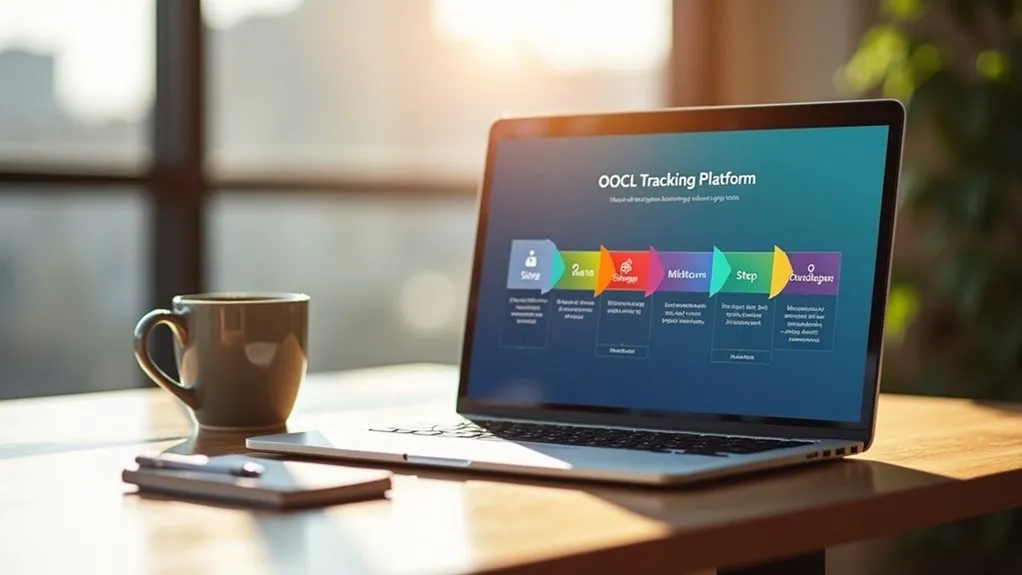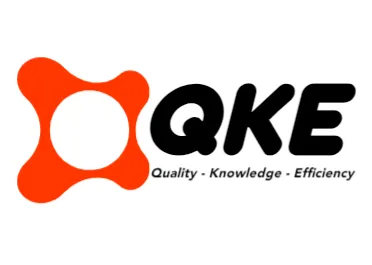OOCL Track and Trace provides a systematic five-step process to monitor shipments effectively. First, access the platform via www.oocl.com or the OOCL mobile app. Second, enter accurate shipment identifiers like Bill of Lading or Container Number. Third, review real-time updates on location and status. Fourth, explore detailed event history for milestones and delays. Finally, utilize advanced tools like email alerts and API integration. Uncover further insights by exploring the comprehensive features available.
Key Takeaways
- Access the OOCL Track & Trace tool on www.oocl.com for basic shipment monitoring without login.
- Enter your shipment identifier like Bill of Lading or Container Number in the correct field.
- Review real-time updates on location, status, and predictive ETAs via the OOCL platform.
- Explore detailed event history for milestones and delay analysis using your shipment ID.
- Set up alerts and use mobile apps for notifications and on-the-go tracking convenience.
Accessing the OOCL Tracking Platform

How can one efficiently access the OOCL Tracking Platform for shipment monitoring? The process begins with the official OOCL website at www.oocl.com, where users can locate the “Track & Trace” section on the homepage for basic tracking without needing login credentials. For enhanced features, the My OOCL Center (MOC) Portal offers comprehensive shipment management, requiring valid login credentials such as an existing CargoSmart ID and password, providing detailed visibility and additional tools like documentation and reports. This portal also ensures real-time updates on shipment location and status, aligning with the sophisticated monitoring capabilities of the OOCL system.
Alternatively, OOCL’s mobile apps, such as OOCL Lite or MyPodium Mobile, deliver on-the-go tracking with push notifications, accessible via app stores for iOS and Android. For businesses seeking automation, API integration enables direct access to OOCL tracking data within internal systems like ERP or TMS, reducing manual errors. Third-party platforms also support tracking with added features, often incorporating API integration for seamless data aggregation across multiple carriers.
Entering Your Shipment Identifiers

Navigating the OOCL Track and Trace system requires precise input of shipment identifiers to ensure accurate monitoring of cargo status. Users must select the correct identifier type—Bill of Lading (B/L), Booking Number, or Container Number—and input it into the designated field on the OOCL platform. Each identifier adheres to specific Entry Formats, such as OOLU followed by 8-12 alphanumeric characters for B/L numbers, or a 4-letter prefix with 7 digits for container numbers.
Navigating the OOCL Track and Trace system demands precise shipment identifier input for accurate cargo monitoring on the platform.
To avoid Identifier Errors, meticulous attention to detail is critical. Consider these key points for successful tracking:
- Verify the identifier type before entry to match the correct field.
- Double-check characters to prevent typos or format mismatches.
- Refer to official documents like the B/L for accurate data.
- Use the provided format guidelines to align with system expectations.
This systematic approach ensures data integrity and seamless access to shipment information.
Reviewing Real-Time Shipment Updates
After ensuring the accurate entry of shipment identifiers, users can proceed to monitor their cargo through the OOCL Track and Trace system. This platform offers real-time data access, enhancing Cargo Visibility by providing live updates on shipment location, transit status, and ETA Adjustments via the OOCL website, mobile app, or integrated platforms like Beacon and GoComet. Users can track specific containers or entire shipments, receiving precise location details on digital maps and notifications for key milestones.
The system’s systematic approach is evident in its structured data presentation, as shown below:
| Feature | Benefit |
|---|---|
| Real-Time Location Updates | Improved supply chain control |
| Predictive ETA Analytics | Proactive delay mitigation |
| Mobile App Accessibility | On-the-go monitoring convenience |
With anytime access, users gain actionable insights for inventory management and delivery coordination, ensuring efficient logistics planning through accurate, data-driven updates.
Exploring Detailed Event History

Why delve into the detailed event history of a shipment? For users of OOCL’s Track & Trace system, this feature offers a chronological audit trail of a container’s journey, accessible via the website or My OOCL Center using a Container, Booking, or Bill of Lading number. It records milestones like Empty Container Pick-Up, Vessel Departure, and Customs Clearance with precise timestamps and locations, ensuring transparency.
The significance of this data is profound, as it supports systematic supply chain management through:
- Delay Analysis: Identifying transit bottlenecks by comparing actual versus estimated times.
- Cost Tracking: Monitoring demurrage and detention to avoid unnecessary expenses.
- Performance Metrics: Evaluating transit times between key events for optimization.
- Visibility: Providing a clear view of container status changes and vessel schedules.
This detailed event history, integrated with vessel and voyage data, empowers shippers and logistics professionals to analyze and refine operations effectively.
Utilizing Advanced Tools and Notifications

How can shippers maximize efficiency in monitoring their cargo? Utilizing advanced tools and notifications offered by OOCL ensures precise, real-time oversight. Through My OOCL Center (MOC), shippers access 24/7 tracking and customizable reports, while the “Hot Shipments” feature enables focused monitoring of critical cargo. Customizing Alerts via email notifications for milestones, exceptions, and demurrage deadlines—configurable up to five days in advance—enhances proactive management. The OOCL Mobile app further supports on-the-go tracking with push notifications for immediate updates and direct customer service communication.
For deeper integration, shippers benefit from Integrating APIs with platforms like ShipsGo or Vizion, connecting OOCL data to internal ERP or TMS systems for streamlined operations. Tools like N2C3 Lite and OOCL Vessel Tracking provide advanced container and vessel monitoring, identifying disruptions early. These systematic solutions, backed by data-driven features, empower shippers to maintain control and optimize supply chain efficiency.

 Tiếng Việt
Tiếng Việt 日本語
日本語 中文 (中国)
中文 (中国) 한국어
한국어
